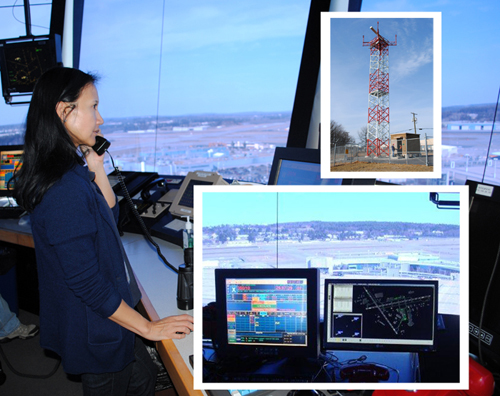On the Ground at Manchester: Making Surface Traffic More Visible
Preventing runway incursions has been a focus within aviation since the Tenerife disaster in 1977 when two 747s collided on the runway in fog. To reduce the probability of airport accidents, Volpe has worked with the Federal Aviation Administration (FAA) to install Airport Surface Detection Equipment, Model X (ASDE-X) at 35 major airports. (Learn more: our ASDE-X work at JFK airport.) The sophisticated ASDE-X system helps improve runway safety by tracking aircraft and vehicles on the tarmac and displaying their positions in the air traffic control tower.
In 2006, the FAA runway safety task force expressed concerns that medium-sized airports were reporting an increasing number of runway incursions. In response, the FAA requested a low-cost ground surveillance (LCGS) deployment strategy for small- and medium-sized airports where installation of ASDE-X is not appropriate.
The process of deploying a new capability nationwide in the National Airspace System (NAS) is structured and methodical, following systems engineering principles and the FAA acquisition process. Volpe initially worked with the FAA to define the user and system requirements for a proposed lower-cost solution, weighing performance and technical requirements along with cost and risk. To deploy a lower-cost solution as quickly as possible, the LCGS team identified vendors with commercial off-the-shelf products that could be integrated and modified to meet the FAA's requirements. The FAA then issued a request for proposals seeking vendors who had systems that could meet these requirements.

After vendor selection and system installation at the airports, Volpe test and evaluation experts set up shop at each airport to conduct extensive on-site evaluation. Volpe recently completed the technical performance on-site testing of one LCGS system at MHT in New Hampshire to determine if it meets system requirements. In June, a Volpe human factors expert will collect data from local air traffic controllers—daily users of the system—to provide a comprehensive user and operational evaluation of the system in the air traffic control environment.
Testing operational systems in-situ is a complex undertaking that requires a large team, a variety of skillsets, various test equipment, and tremendous cooperation of air traffic control management and staff, and the local airport operations and managing authority. Adding to the logistical complexity of the project is that some of the on-site testing is done while the airport is involved in normal operations.
Technical testing and user evaluation testing will be conducted at each of the five test airports. The final LCGS system is intended to provide a safety benefit during low-visibility periods. After the operational evaluation phase of each system, the FAA will go through the NAS certification process, enabling small- to medium-size airports to receive the safety benefits of a surface surveillance system.
For more information on the project, contact Sarasina Tuchen, electronics engineer and project manager at (617) 494-3397.

Technical Evaluation Approach
Technical evaluation of the surveillance system requires two weeks at the airport and eight weeks of off-site data collection. At MHT, the team conducted 12 separate test scenarios. One test was conducted to establish the probability that different target sizes could be detected by the surveillance system. Another test assessed the area over which the system could effectively track moving vehicles.
To establish that the system can accurately track small aircraft and ground vehicles, small aircraft and ground vehicles traversed taxiways, and positional errors were measured. To evaluate the system during aircraft maneuvers, a small plane with a Volpe staff pilot performed take-off and landing maneuvers while the measurement team assessed position error. Off-site testing involves collecting recorded track data over a period of weeks and analyzing the data for various anomalies, missed detections, and false tracks over this period.
